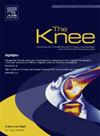负重伸展活动中双十字稳定和后路稳定全膝关节置换术前路稳定的效果
IF 2
4区 医学
Q3 ORTHOPEDICS
引用次数: 0
摘要
背景:双十字稳定(BCS)和后稳定(PS)是两种常见的全膝关节置换术(TKA),其中BCS TKA提供双十字韧带的机械替代,而PS TKA仅提供后十字韧带(PCL)的替代。本研究的目的是通过评估负重伸展活动中PS和BCS TKA的负重运动学,量化TKA前路稳定是否会影响完全伸展运动。方法对81例分别由2位外科医生植入BCS(47)或PS (34) TKA的患者进行体内三维运动学分析。所有受试者被要求在透视监视下进行负重提升活动(SU),并使用3d到2d图像配准来确定运动学,如外侧前/后位置、内侧前/后位置、轴向旋转和凸轮/后啮合。结果BCS TKA受试者在完全伸展时能达到更大的过伸(p <;0.0001)。在完全伸展时,BCS TKA的位置也比PS TKA更前(p <;0.0001),与PS TKA相比,它从最大屈曲到完全伸展的两髁前运动也更多(p <;0.0001)。结论本研究结果表明,BCS TKA的设计差异,如前路稳定,可能有利于实现更多的髁突运动和接近完全伸展的轴向旋转,最终有助于重建TKA的天然螺钉-家机制。本文章由计算机程序翻译,如有差异,请以英文原文为准。
The effects of anterior stabilization in Bi-cruciate stabilized and posterior stabilized total knee arthroplasty during a weight-bearing extension activity
Background
Bi-Cruciate Stabilized (BCS) and Posterior-Stabilized (PS) are two common total knee arthroplasties (TKA), where the BCS TKA offers mechanical substitution of both cruciate ligaments, while the PS TKA only offers substitution of the Posterior Cruciate ligament (PCL). The purpose of this study is to quantify whether anterior stabilization in TKA affects full extension kinematics by evaluating the weight-bearing kinematics for PS and BCS TKAs during a weight-bearing extension activity.
Methods
In-vivo 3D kinematics were determined for 81 subjects having a BCS (47) or PS (34) TKA implanted by two different surgeons. All subjects were asked to perform a weight-bearing step-up activity (SU) under fluoroscopic surveillance, and 3D-to-2D image registration was used to determine kinematics such as lateral anterior/posterior position, medial anterior/posterior position, axial rotation, and cam/post engagement.
Results
The BCS TKA subjects were able to reach greater hyperextension than the PS TKA subjects at full extension (p < 0.0001). The BCS TKA was also positioned statistically more anterior than its PS counterpart at full extension (p < 0.0001), and it also experienced more anterior motion of both condyles from maximum flexion to full extension than the PS TKA (p < 0.0001).
Conclusion
The results in this study suggest that the BCS TKA design differences such as anterior stabilization could be beneficial for achieving more condylar motion and axial rotation near full extension, ultimately helping to recreate the native screw-home mechanism in TKA.
求助全文
通过发布文献求助,成功后即可免费获取论文全文。
去求助
来源期刊

Knee
医学-外科
CiteScore
3.80
自引率
5.30%
发文量
171
审稿时长
6 months
期刊介绍:
The Knee is an international journal publishing studies on the clinical treatment and fundamental biomechanical characteristics of this joint. The aim of the journal is to provide a vehicle relevant to surgeons, biomedical engineers, imaging specialists, materials scientists, rehabilitation personnel and all those with an interest in the knee.
The topics covered include, but are not limited to:
• Anatomy, physiology, morphology and biochemistry;
• Biomechanical studies;
• Advances in the development of prosthetic, orthotic and augmentation devices;
• Imaging and diagnostic techniques;
• Pathology;
• Trauma;
• Surgery;
• Rehabilitation.
 求助内容:
求助内容: 应助结果提醒方式:
应助结果提醒方式:


